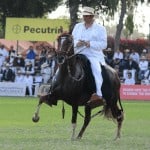
By Renzo Crolle Claux
I am writing this article motivated by a great concern that we as aficionados to the Peruvian Paso Horse, need to focus on where we should evolve, both in development and breeding.
The National Association of Breeders and owners of Peruvian Paso Horses (ANCPCPP), must be the governing body of this direction, but the reality, not just recently, is quite far from that ideal.
We must not fail to highlight the huge evolution that our horse has taken, in my view, during the past 25 years, due to the individual effort of hundreds of breeders both in Peru and abroad, but without following the breed standard set by the governing body of the breed, which is the ANCPCPP.
The majority of the time we spend discussing matters of competitions and judging, but we are not discussing, nor generating the mechanisms for what we should be discussing – the upbringing and development of the Peruvian horse.
The main work of the ANCPCPP, as its name indicates “Breeders’ Association”, should be to create the outline, regulation of breeding and define a breed standard. The breed standard should not be static, but should be reviewed at least every 8 years minimum – time enough to be able to analyze the trends in the development of breeding.
To achieve these 3 key aspects for the breeding of any species, we should consult with and convene with specialists in the matter, i.e. equine technicians and equine veterinarians.
Important points on the table to detail:
– History, evolution and traditions of the Peruvian Horse.
– Uses of the Peruvian Horse
– Anatomy and morphology of the Peruvian Horse.
– Dynamics and movement of the Peruvian Horse.
– Genetics and records of the Peruvian Horse.
– Health of the Peruvian Horse.
– Training methods of the Peruvian Horse.
– Judging Methods and Judges of the Peruvian Horse (depending on your discipline).
These 8 aspects at the same time serve as a basis for discussion and implementation of this major transformation, which I’m urging to be done immediately. This could be the curriculum of the course of Equinotecnia that the ANCPCPP should organize, with an interval of at least every 2 years to promote and inculcate the learning what was, is, and will be our Peruvian Horse.
Today there is a lot of talk about the professionalization in judging the Peruvian Horse (hiring outside professional judges) and that is the solution to all problems.
I do not think that alone is the solution to the problem, but I recognize it is an important point within the integral change that is needed in both in breeding, as in the dissemination of the Peruvian Horse.
In the first place all judges must be Equine technician. On this path of professionalization, the judges committee should aim to be a purely technical entity, and not political as sometimes tends to be.
Judging should be completely impartial and free of conflicts of interest; probably a pool of judges is an alternative. Judging should be in constant observation by a committee assigned to audit, analyzing if you are complying with the guidelines established. In terms of judging itself, not only must be classifying but also qualifying, i.e. comparing entries between themselves and additionally against the established breed standard.
All these points will help to make a work more professional and technical by the judges.
Finally, I should like to point out that these are only some aspects of the utmost importance, but that in no way are the only ones.
